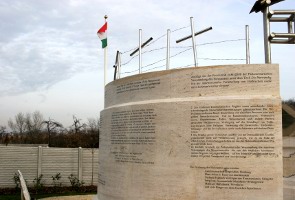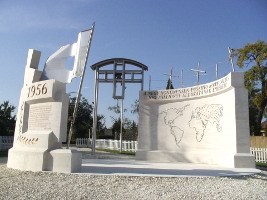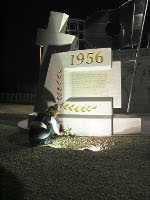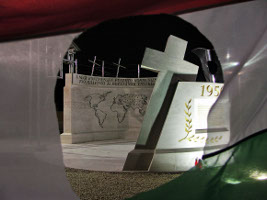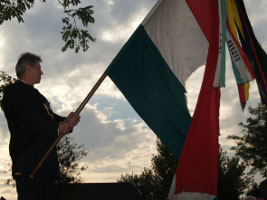The Memorial
The memorial commemorates the 100 million victims of communism and the revolution and freedom fight of 1956. It was built by public subscription and revealed on 21 October 2006.
The arched big wall (let us call it the “world-wall”) was built around a circular base, which represents the world itself. It extends from the centre of the circle at right angles (i. e. a quarter of a circle), because a quarter of the world was affected by the demolishing concept of communism. This appears on the map of the four continents which have been slid apart; the affected territories are marked with lead rosettes which visually explain and show the obvious order of this demolition. On top of the arched, impenetrable brick wall, there are crosses as symbols of respect to the victims, a traditional and well-known emblem of Christianity. The irregular barbed-wire fence recalls the inhumanity of the death camps and prisons. The material of the memorial is frost proof hard limestone from Turkey. The site is János Víg’s work, who is a sculptor and restaurator from Gödöllő. The belfry with the knell was built together with the world-wall. When the knell is tolled it is a message of sympathy and respect to all the victims of communism around the world. This is indicated on the wall by lead thorns. There is a glossy Latin cross of rustproof steel in the middle of the belfry symbolising Christian faith, the promise of future, which overcomes misery and human suffering. The knell was cast by Miklós Gombos, a master bell founder.
The arched memorial of 1956 comes out from the world-wall as a battleship, symbolizing the fact that the revolution of 1956 was the first event in the world to hit a hole in the concrete wall of communism. It also marks the beginning of the end of communism, which subsequently collapsed in most areas of the world shortly after. On the inside wall of the monument the viewer can see Hungary’s enlarged historic map coming out from the world-wall, meanwhile the Latin stone cross is leaning to the triumphant wall of ‘56. The stone cross is to symbolise that Hungary was the first to shoulder the “cross of responsibility” in the fight against communism. On the outside wall of the monument you see the date of 1956. The quote under from a Sinka poem is perfectly in harmony with the branch carved, gilded as a symbol of the glorious event. (István Sinka, whose carved memorial column stands facing the Council House, lived in Csömör in 1944 and 1945.) On the front of the memorial, there is the rustproof, shiny, victorious ’56 steel flag with the famous hole in the middle. During the revolution, the freedom fighters cut out the “coat of arm of Rákosi” from the middle of the flag. Rákosi was the communist leader at that time. This flag has been used as a symbol of 1956 ever since.

